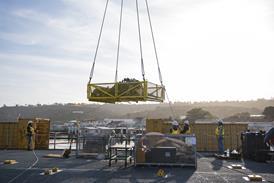There are few things that can be said in favour of flying straight towards a large outcrop of Arizona rock that extends rather higher than the current altitude of the aircraft in which you are located.
One is that the experience tends to distract you temporarily from what the strong desert updraughts are doing to your stomach.
A second is that the instrument being demonstrated in the cockpit of the elderly Convair 580 that Phoenix, Arizona-based AlliedSignal Aerospace uses as a testbed should shortly be available to help general aviation pilots avoid one of the most common causes of aviation accidents.
Controlled flight into terrain has been tackled by ground proximity systems for some years and second-generation systems are now on board most classes of aircraft, from airliners to business jets.
AlliedSignal Aerospace now plans to extend its range of Enhanced Ground Proximity Warning Systems (EGPWS) down to the general aviation (GA) sector with a paperback book-sized version, weighing around 750 grams (1.5lb).
Deliveries
Announced last month, first production deliveries of AlliedSignal's new GA EGPWS are expected early in 2000.
It will cost "less than $10,000", says the company, compared with the $23,900 for its Mark VI designed for regional airliners and smaller business jets and $68,000 for the Marks V and VII, designed for large air transport aircraft.
"The EGPWS has proven to be an incredibly effective deterrent to controlled flight into terrain, which is still the number one cause of aircraft fatalities worldwide, and our plan is to put the system within reach of nearly everyone who flies," says Frank Daly, president, AlliedSignal Aerospace Avionics & Lighting.
The company's EGPWS combine a radar altimeter with a terrain database and Global Positioning System (GPS), so the aircraft knows its position relative to potentially hazardous terrain.
Source: Flight Daily News























